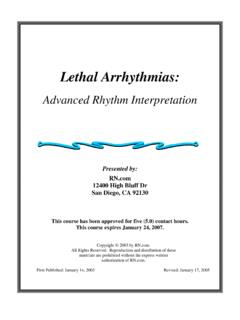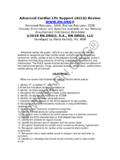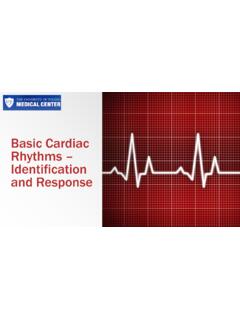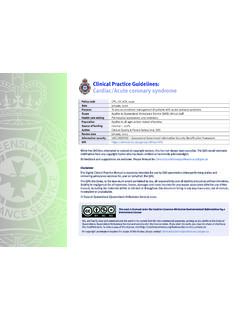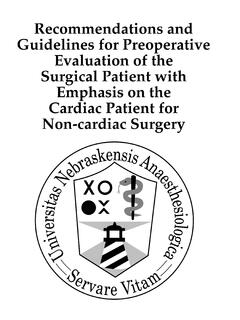Transcription of Technetium- Pyrophosphate Imaging for Transthyretin ...
1 99mTechnetium- Pyrophosphate Imaging for Transthyretin cardiac AmyloidosisASNC cardiac AMYLOIDOSIS PRACTICE POINTS 1 Copyright 2019 American Society of Nuclear CardiologyOVERVIEWThe purpose of this document is to identify the critical components involved in performing 99mTechnetium- Pyrophosphate (99mTc-PYP) Imaging for the evaluation of cardiac Transthyretin amyloidosis (ATTR). BACKGROUND The majority of individuals with cardiac amyloidosis have myocardial amyloid deposits formed from misfolded light chain (AL) or Transthyretin (TTR) proteins. Diagnosis of amyloidosis and differentiation between the types is important for prognosis, therapy, and genetic counseling.
2 cardiac ATTR amyloidosis, the focus of this practice points document, is an under diagnosed cause of heart failure. Amyloid derived from wild-type TTR results in a restrictive cardiomyopathy, most commonly presenting in men in their early 70 s onwards, but occasionally seen as young as age 60. Although almost 1 in 4 males > 80 years have some TTR-derived amyloid deposits at autopsy, the clinical significance of a mild degree of deposition is unknown--generally clinical manifestations of heart failure occur once enough amyloid has been deposited to cause LV wall thickening (1). Approximately 3 4% among US African Americans have a common inherited mutation of the TTR gene (Val122 Ile), which produces a restrictive cardiomyopathy in a minority, but may contribute to heart failure in a higher proportion (1).
3 cardiac amyloidosis should be suspected in individuals with heart failure and thickened ventricles with grade 2 or greater diastolic dysfunction on echocardiography or typical findings on cardiac magnetic resonance Imaging (CMR; diffuse late gadolinium enhancement, ECV expansion or characteristic T-1 relaxation times); diagnosis is confirmed by endomyocardial biopsy and typing of amyloid fibrils as needed. Several studies confirm the high sensitivity and specificity of 99mTc-bone compound scintigraphy [99mTc-3,3-diphosphono-1,2-propanodicarb oxylic acid (DPD) or PYP (2, 3] for cardiac ATTR 99mTechnetium- Pyrophosphate Imaging for Transthyretin cardiac Amyloidosis cardiac AMYLOIDOSIS ASNC PRACTICE POINTS2 cardiac AMYLOIDOSIS ASNC PRACTICE POINTS amyloidosis; recent studies highlight the value of DPD and/or PYP in differentiating cardiac ATTR from AL amyloidosis (4).)
4 A distinct advantage of 99mTc-PYP Imaging , even when echocardiography and CMR are diagnostic for cardiac amyloidoisis, is its ability to specifically identify ATTR cardiac amyloidosis non-invasively and thereby guide patient management (5). PATIENT SELECTION Individuals with heart failure and unexplained increase in left ventricular wall thickness. African-Americans over the age of 60 years with heart failure, unexplained or with increased left ventricular wall thickness (>12 mm). Individuals over the age of 60 years with unexplained heart failure with preserved ejection fraction. Individuals, especially elderly males, with unexplained neuropathy, bilateral carpal tunnel syndrome or atrial arrhythmias in the absence of usual risk factors, and signs/symptoms of heart failure.
5 Evaluation of cardiac involvement in individuals with known or suspected familial amyloidosis. Diagnosis of cardiac ATTR amyloidosis in individuals with CMR or echocardiography consistent with cardiac amyloidosis. Patients with suspected cardiac ATTR amyloidosis and contraindications to CMR such as renal insufficiency or an implantable cardiac device (5).OBTAINING THE RADIOTRACER 99mTc-PYP is readily available as unit doses from commercial radiopharmaceutical distributors or as kits for preparation. Kits containing 5 or 30 single-use vials are commercially available. Each 10 ml vial contains mg of sodium Pyrophosphate and mg of stannous chloride and mg of total tin, and this kit is approved for bone, cardiac (for the detection of myocardial infarction), and blood pool (radionuclide ventriculography and GI bleeding) Imaging (see package insert for details of reconstitution of 99mTc-PYP).
6 The total body effective dose from 15 mCi of 99mTc-PYP is estimated at mSv. 99mTc-DPD is not available for clinical use in the United States. Although there are no large studies directly comparing the agents, the principles in this document apply similarly to 99mTc-DPD and 99mTc-PYP AMYLOIDOSIS ASNC PRACTICE POINTS 3 TEST PREPARATION No specific test preparation is PROCEDURE Commonly used Imaging procedures for 99mTc-PYP Imaging are shown in Table 1. Individual centers can modify Imaging procedures based on local camera capabilities and expertise. cardiac or chest SPECT and planar images are obtained one hour after injection of 99mTc-PYP using the parameters listed in Table 1.
7 If persistent blood pool activity is noted on one hour images ( , renal failure), delayed images may be obtained at 3 hours. Planar Imaging is rapid, simple to perform, and useful for visual interpretation and quantification of the degree of myocardial uptake (see image interpretation) by heart-to-lung ratio or comparison to rib uptake. SPECT Imaging may be helpful to 1. avoid overlap of bone uptake 2. distinguish blood pool activity from myocardial activity (3) 3. assess the distribution of myocardial 99mTc-PYP uptake in individuals with positive planar scans4. identify 99mTc-PYP uptake in the interventricular septum (commonly involved in amyloidosis) and 5.
8 Quantify the degree of myocardial uptake by comparison to rib uptake. Whole body planar Imaging may be helpful to identify uptake of 99mTc-PYP in the shoulder and hip girdles (a specific sign of systemic ATTR amyloidosis) (6) and should be considered adjunctive and optional in addition to standard cardiac -centered Imaging , based on local expertize. The value of 99mTc-PYP Imaging with the newer cardiac only SPECT cameras needs further validation (due to inability to accurately display bone and lung 99m Tc-PYP uptake with these systems; see image interpretation section).4 cardiac AMYLOIDOSIS ASNC PRACTICE POINTS Table 1.
9 Imaging Parameters for cardiac 99mTc-PYP ImagingImaging proceduresParametersPatient PreparationNo specific preparation. No fasting scanDose of 99mTc-PYP10-20 mCi intravenouslyTime between injection and acquisitionRecommended: 1-hour SPECT and planar; Optional: 3-hour SPECT or planar Imaging parameters Field of viewRecommended: cardiac or chest; Optional: Whole body planarImage typeRecommended: cardiac or chest SPECT and planar imagingPositionSupine Energy window140 keV, 15-20%Collimators Low energy, high resolutionMatrixPlanar: 256 by 256, at least 64 by 64 is required. SPECT: 128 by 128, at least 64 by 64 is mmPlanar Imaging specific parametersNumber of views*Anterior, Lateral, and Left Anterior ObliqueDetector configuration90 degrees Image duration (count based)750,000 countsMagnification Imaging specific parametersAngular range Recommended: 180 degrees; Optional: 360 degreesDetector configurationRecommended 90 degrees; Optional 180 degreesECG gatingOff; Nongated imagingNumber of views/detector 40 Time per stop20 *Anterior and lateral views can be obtained at the same time using a 90-degree detector configuration.
10 Lateral planar views or SPECT Imaging may help separate sternal from myocardial AMYLOIDOSIS ASNC PRACTICE POINTS 5 IMAGE INTERPRETATION The anterior and lateral planar images as well as the rotating projection images and reconstructed SPECT images are reviewed in standard cardiac Imaging planes using commercial software. Myocardial 99mTc-PYP uptake patterns are categorized as absent, focal, diffuse or focal and diffuse. When myocardial uptake is visually present on SPECT images H/CL ratios of at one hour are classified as ATTR positive and ratios of < ATTR negative (4).Quantifying Myocardial 99mTc-PYP UptakeThere are two approaches to quantification:1.


